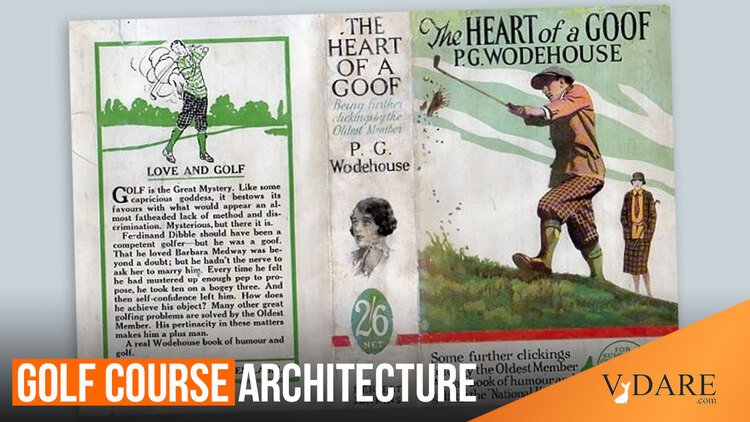Earlier: Swan Fighting, PG Wodehouse Style
Steve Sailer writes, below, that:
Seth Raynor (1874-1926) was a civil engineer hired in 1909 by Charles Blair Macdonald (1855-1939), the Canadian-American-Scottish originator of American golf course architecture, to help him build the National Golf Links of America in the Hamptons on Long Island. NGLA isn’t located on quite as awesome land as Pebble Beach or Ballybunion, but it’s the most fun golf course I’ve ever played.
As Macdonald downshifted his career in old age, Raynor, who never claimed to be much of a golfer, went on to build many dozens of golf courses using the “template” holes that Macdonald had picked out following a tour of the best golf courses in Scotland and England around 1900.
![]() This reminds me of what P. G. Wodehouse, who before the Second World War shuttled back and forth between America and England with some regularity, wrote in his preface to his second golf story book, The Heart of a Goof, in 1926, when the National Golf Links were only 15 years old.
This reminds me of what P. G. Wodehouse, who before the Second World War shuttled back and forth between America and England with some regularity, wrote in his preface to his second golf story book, The Heart of a Goof, in 1926, when the National Golf Links were only 15 years old.
He didn’t enjoy them quite as much:
One final word. The thoughtful reader, comparing this book with The Clicking of Cuthbert, will, no doubt, be struck by the poignant depth of feeling which pervades the present volume like the scent of muddy shoes in a locker-room: and it may be that he will conclude that, like so many English writers, I have fallen under the spell of the great Russians.
This is not the case. While it is, of course, true that my style owes much to Dostoievsky, the heart-wringing qualities of such stories as ”The Awakening of Rollo Podmarsh” and ”Keeping in with Vosper” is due entirely to the fact that I have spent much time recently playing on the National Links at Southampton, Long Island, U.S.A. These links were constructed by an exiled Scot who conceived the dreadful idea of assembling on one course all the really foul holes in Great Britain. It cannot but leave its mark on a man when, after struggling through the Sahara at Sandwich [Sandwich is the course that Ian Fleming played in real life and James Bond in fiction] and the Alps at Prestwick, he finds himself faced by the Station-Master’s Garden hole at St. Andrew’s and knows that the Redan and the Eden are just round the corner. When you turn in a medal score of a hundred and eight on two successive days, you get to know something about Life.




 This reminds me of what P. G. Wodehouse, who before the Second World War shuttled back and forth between America and England with some regularity,
This reminds me of what P. G. Wodehouse, who before the Second World War shuttled back and forth between America and England with some regularity, 








